We’ve all seen fields of white towers with sweeping blades. These wind farms can generate electricity for hundreds of homes. But did you know that you can get a small wind turbine for home use?
The technology has been shrunk so that homeowners may harness the power of the wind for themselves. Small wind turbines can decrease your utility bill and save you money in the long run.
However, there seems to be a lot of mystery behind small wind turbines; they appear complicated and exclusive. So we’ve written this guide to clear any uncertainty and help you choose your very own wind turbine!
Table of Contents
Can A Small Wind Turbine Power A Home?
A small wind turbine can decrease your utility bill from 50% to 90%. With a large enough system and the right wind conditions, you can use wind energy to power your home.
The amount of energy that the turbine creates depends on the following factors:
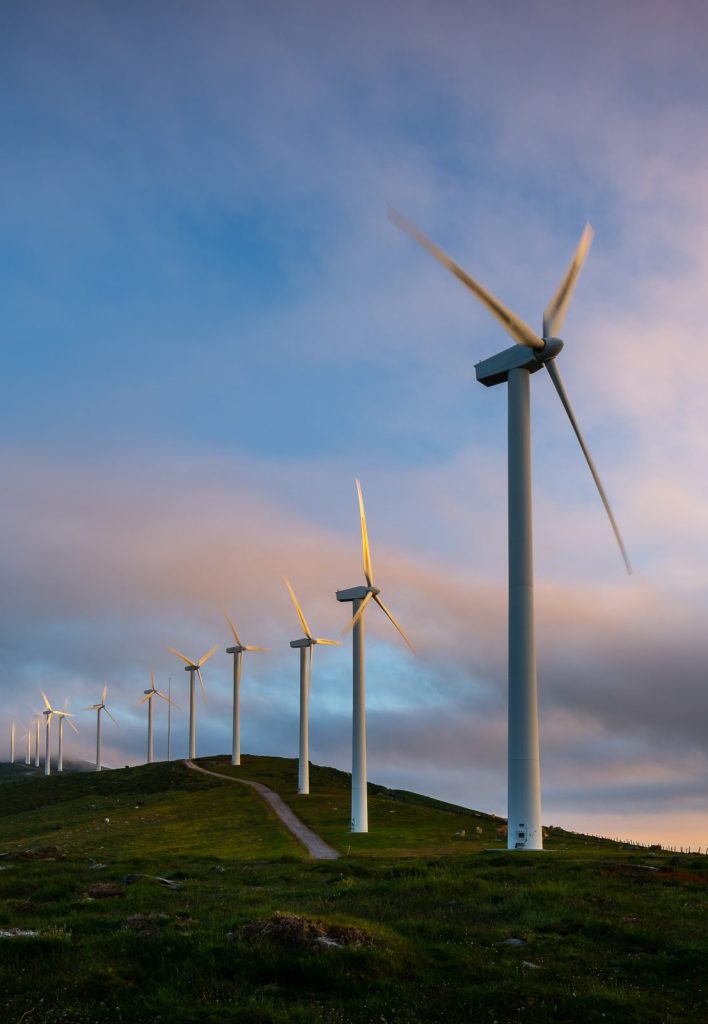
The turbine power curve — shows the relationship between the wind speed and turbine power. It displays the performance of the wind turbine.
The average wind speed in your area — small wind turbines need 3 – 25 mph to be effective. A 20 mph wind will generate 600 watts per square foot of turbine area. We’ll explain what “per square foot” means in the next section.
The height of the wind turbine tower — the higher the wind turbine tower, the more efficient the turbine will be. Wind speeds increase further away from the ground allowing the turbine to produce more power.
The speed frequency distribution — this graph shows the different wind speeds expected at varying times of the year. Specifically, it shows the number of hours expected per wind speed class.
Residential wind turbines produce anywhere between 400 watts and 10 kilowatts of power. However, a typical American home uses 877 kWh per month.
Using these numbers, a 1.5 kW turbine in 14mph wind will save 34% of the home’s utility bill. However, these figures depend entirely on the turbine efficiency and the mentioned factors.
How Does A Small Wind Turbine Work?
The aerodynamic blades of a wind turbine catch the wind, which then turns a rotor. This rotor turns the kinetic energy from the wind into electrical power, which we can use.
A typical wind turbine consists of blades, a rotor, a generator/alternator, a tail, and a tower. It also includes all the necessary wiring and a balancing system.
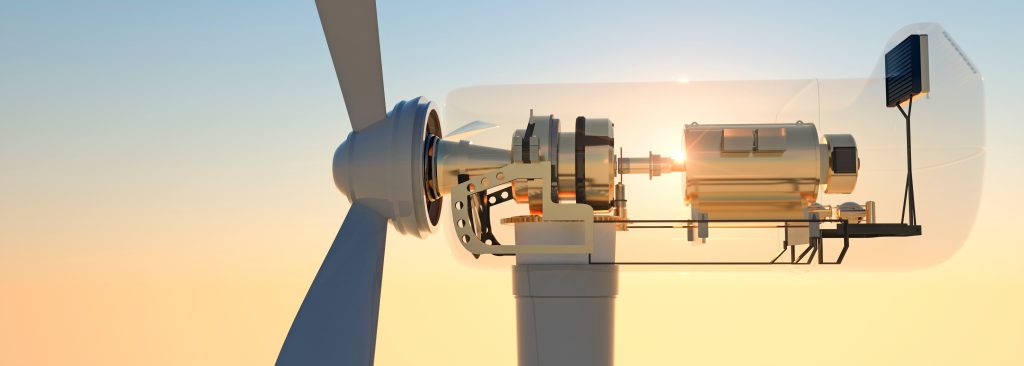
Source: Adobe Stock
The size of a turbine’s blades determines how much kinetic energy it can collect from the wind. For example, a 23-foot blade can generate 23 kW of electricity.
Small wind turbines come in different sizes to meet your energy demand. For example, you can use microturbines to charge batteries or power sailboats. These turbines range from 20 watts to 500 watts. Larger turbines are used for houses and can generate up to 100 kW.
The standard turbine blade sizes are as follows:
| Blade Size (Ft) | Sweep Area (Ft. Sq.) | Electricity in 20mph Wind (kW) |
|---|---|---|
| 3 | 7 | 0.39 |
| 6 | 28 | 1.56 |
| 10 | 78 | 4.35 |
| 13 | 133 | 7.42 |
| 16 | 201 | 11.20 |
| 20 | 314 | 17.50 |
| 23 | 415 | 23.13 |
When a wind turbine has a larger blade, the area where it can catch the wind is greater. Therefore, turbines with greater “wingspans” will be able to generate more electricity. As mentioned above, a turbine with 20 mph wind will generate 600 watts per square foot.
How Many Small Wind Turbines Does Your Home Need?
Before you jump right in and buy a small wind turbine, you need to calculate if it’s economically viable. Then, you’ll have to plan which turbine is for you and find out if enough wind is on your site.
Planning
When planning your wind turbine project, you need to keep the following in mind:
- Where are you erecting your turbine?
- What wind resources are available?
- Is it economically viable?
Wind Resource
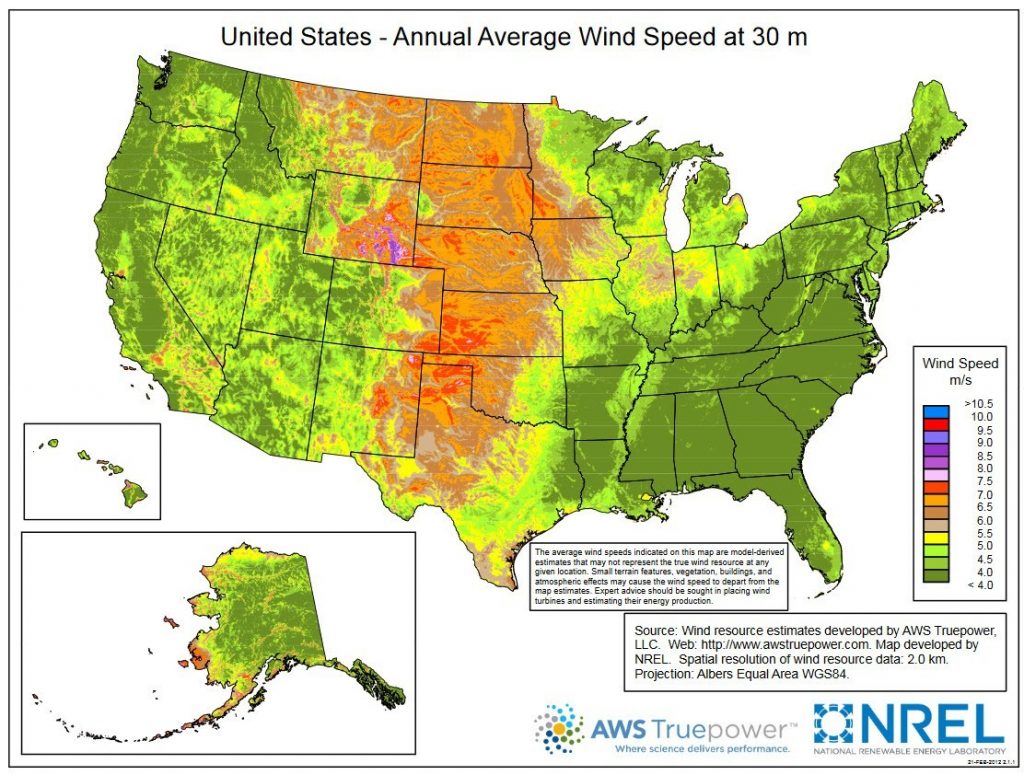
Source: windexchange.energy.gov
To determine what type of wind turbine you need, you have to know the available wind resource on your site. The minimum recommended wind speed is 9 miles per hour. However, the turbine will be most efficient around the 14 mph mark.
Here you’ll be able to find a wind resources map to find out your available wind resource. However, maps at larger scales won’t be 100% accurate to your site. Therefore, using local wind data will give you a better understanding of your available wind resource.
Local information resources include:
- Airport wind speed data
- Vegetation growth
- An existing wind measurement system
- Data from a local wind system
If the wind is abundant on your site, you’ll only need one turbine. However, if you have minimal wind, you might need two or three to meet the same output.
Economics
When deciding if a wind turbine is for you, you’ll need to determine if it’s financially viable; this will influence how many turbines you can afford to buy.
When calculating the feasibility of a small wind turbine, it’s best to get information straight from the supplier. They will tell you the costs, output, maintenance fees, savings, and payback of the system.
The typical lifespan of a small wind turbine is 20 years. After that, it would need heavy maintenance. So a wind turbine isn’t feasible if it takes you longer than that to regain the investment.
Determining How Many Wind Turbines You’ll Need
Once it’s clear that it’s economically suitable, you can start planning your system.
The first step is determining how much electricity your home uses and what you’d like to offset that by. For example, in 2020, the average American home used 10,715 kWh. That averages at 893 kWh per month.
The next step is taking note of your average wind speed. Of course, this will change per month, and using an average won’t be 100% accurate. You should take this into account when doing your research.
We’ll use a wind speed average of 14mph for our example. This speed will produce 19.12 watts per square foot.
Therefore, a wind turbine with an area of 78.54 square feet (10 ft diameter) will produce 1.5 kW.
Unfortunately, the wind does not have a consistent speed of 14mph. Therefore, the 1.5 kW will only be generated in ideal conditions. Therefore, this small wind turbine will generate 300 kWh of electricity per month.
In conclusion, you’ll either need 3*1.5 kW small turbines or a turbine with a larger sweep area.
Is It Worth It?
Though this small turbine can’t power your home, it can save you 34% of your electrical bill — around $39 per month. So you’ll be saving $468 annually.
You get a hybrid system when you join a wind turbine with other alternative methods like solar power. These hybrid systems make up for energy loss due to inefficiency and can power your whole home.
However, whether or not a small wind turbine is suitable for your home depends on the cost. For example, it’s not worth it if it takes longer to regain the investment than the system’s lifespan.
How Much Does A Small Wind Turbine For A House Cost?

Source: ubuy
In 2019 the average wind turbine cost $8,300 per kilowatt. In 2022 it’s closer to $1,000 per kilowatt. However, prices vary depending on installation and utility network connections.
After a quick consumer market analysis, we’ve found that most small wind turbines are 500w. These turbines cost an average of $1,020 but range from $260 to $2,000. This works out to $2 per watt.
However, since 500w will be more suited for batteries, you’ll need higher wattage for your home.
According to checktrade.com, you can buy a 2.5kW roof-mounted turbine for $2000. Alternatively, a freestanding 2.5kW turbine will cost $7000 due to the structure needed.
The cost of a small wind turbine for your home also depends on which turbine you buy — did you know that there are both horizontal and verticle turbines?
Horizontal turbines are the most commonly available, while verticle turbines are relatively new.
Verticle turbines cost considerably less but are smaller, producing less electricity. They’d be a good choice if you’re limited on space — a 200w turbine of this variety goes for $270.
What Is The ROI Of A Small Home Wind Turbine?
First, let’s define what return on investment (ROI) means. The ROI is a measurement to see if an asset is profitable. It’s calculated by dividing the return on the investment by its cost.
We’ve briefly touched on this earlier when discussing if a small wind turbine for your home is worth it. Simply put, the ROI of your wind turbine would be savings made divided by the cost.
We will use the following formula:
ROI = (Savings in electricity – Cost of the turbine)/cost of the turbine
Savings in electricity: The average wind turbine lasts 20 years. If we say that a 1.5kW turbine saves you 34% of your electrical bill, it saves $468 a year. in 20 years, you would have saved $9,360
Cost of the turbine: Let’s take the average of $1,000 per kW. That same 1.5kW turbine would cost $1,500 (Not including installation fees).
Now, let us plug these values into the formula:
ROI = (9360 – 1500)/1500
ROI = 52%
However, this rate will change depending on:
- Installation costs
- The kW of your turbine
- The wind speed in your area
Therefore, you should do your ROI calculations using the values you received from your local installer.
Do You Need Planning Permission For A Small Home Wind Turbine?
Wind turbines need to meet zoning requirements and/or a permit to be able to install one in your backyard.
Zoning refers to regulations applied to your specific area. For example, a common zoning law restricts building heights to 35 ft, whereas permits refer to specific standards and codes for projects within your zone.
Zoning regulations and building permits vary depending on your country and state. Contacting your regional building inspector or board of planning will be the best way to discover your specific regulations.
Another thing to remember is that there might be aesthetic issues with your turbine project. For example, neighbors can object to your wind turbine if it ruins their view or decreases their property value. Therefore, you should always speak to your neighbors first and contact your local homeowner’s board.
Often neighbors will be concerned about the amount of noise a wind turbine will make. Fortunately, your average small wind turbine for home use will be 55db. That makes a turbine no louder than a household fridge.
3 Best Small Wind Turbines For Homes
1. Windmax HY400 500 Watt
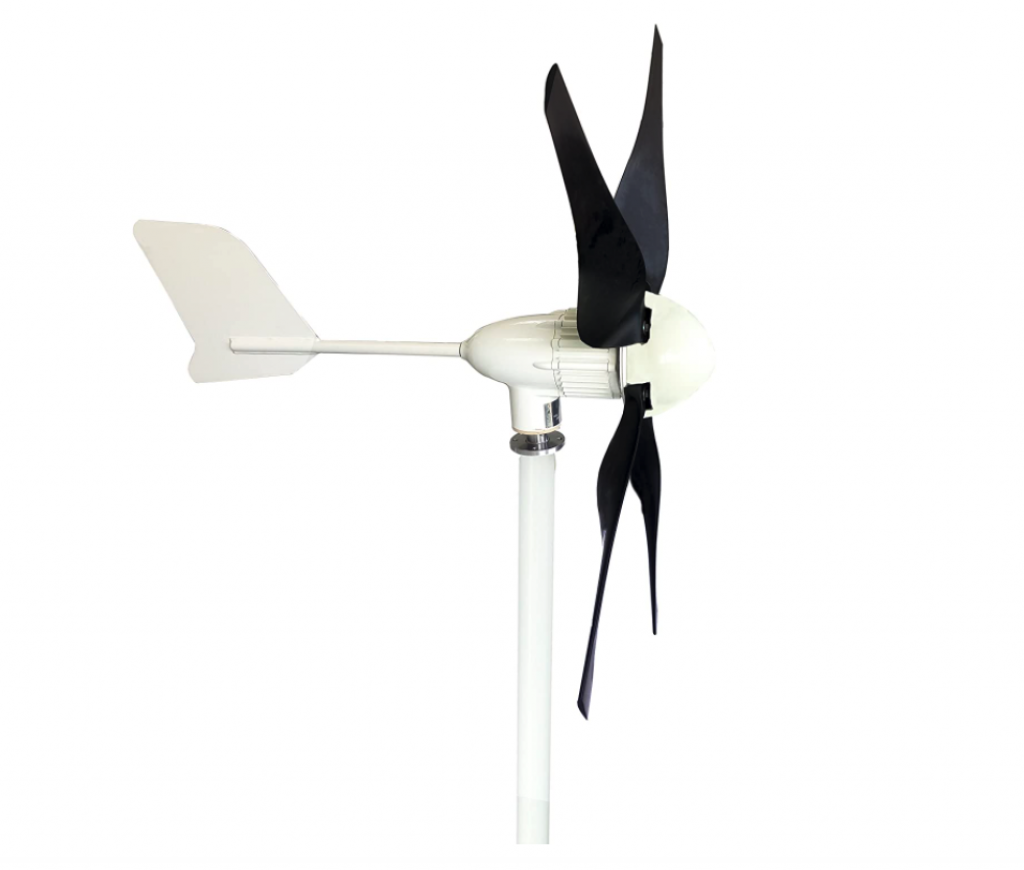
This wind turbine is perfect for those wanting to get started. It has five blades to harness the wind more effectively.
The turbine can produce 500 watts of electricity. While this can’t power your home, it’s perfect for offsetting your electrical bill.
In addition, its low price won’t leave you wondering if it’s worth it.
2. Automaxx Windmill 1500W
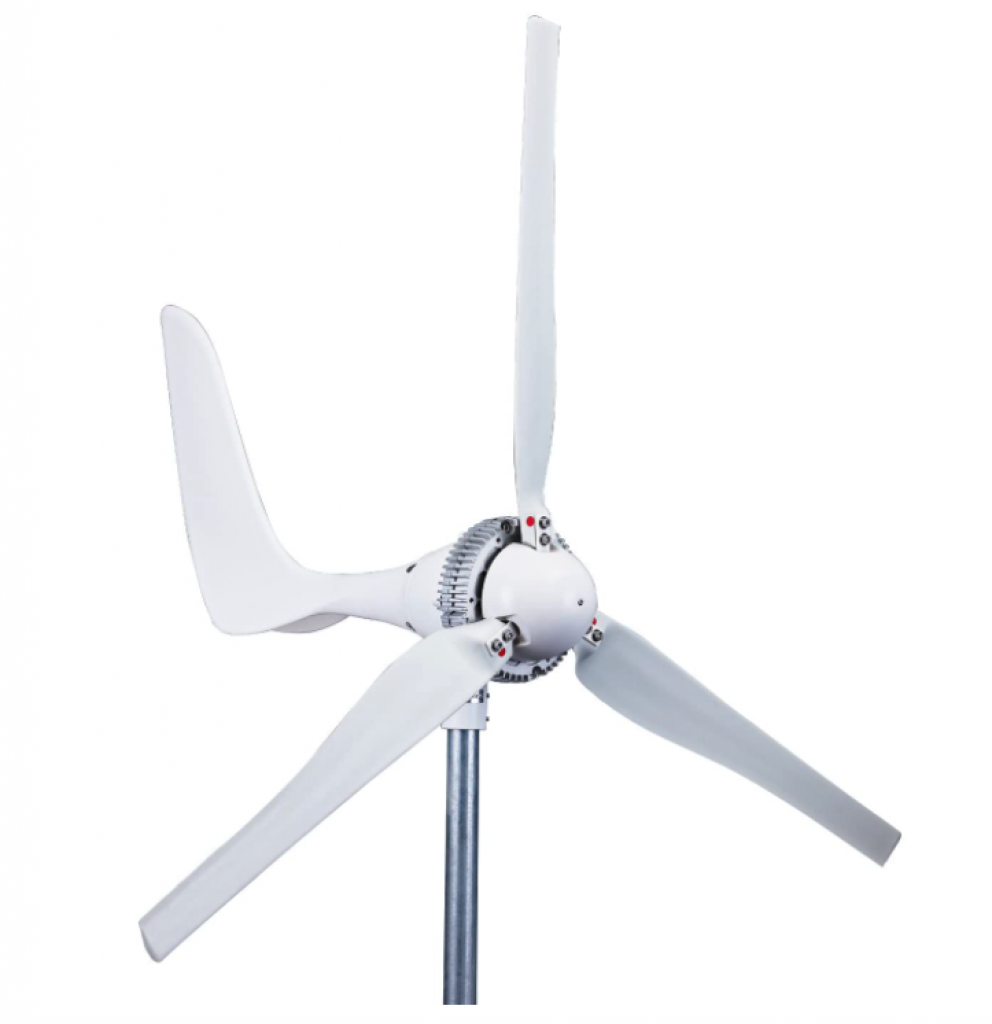
The Automaxx Windmill can generate 1.5kW of electricity which is excellent for its price!
For $1,895 this small wind turbine will be able to save you 34% of your energy bill.
While it is more expensive than a 500w turbine, it’s worth the investment!
1. Nature Power 70701
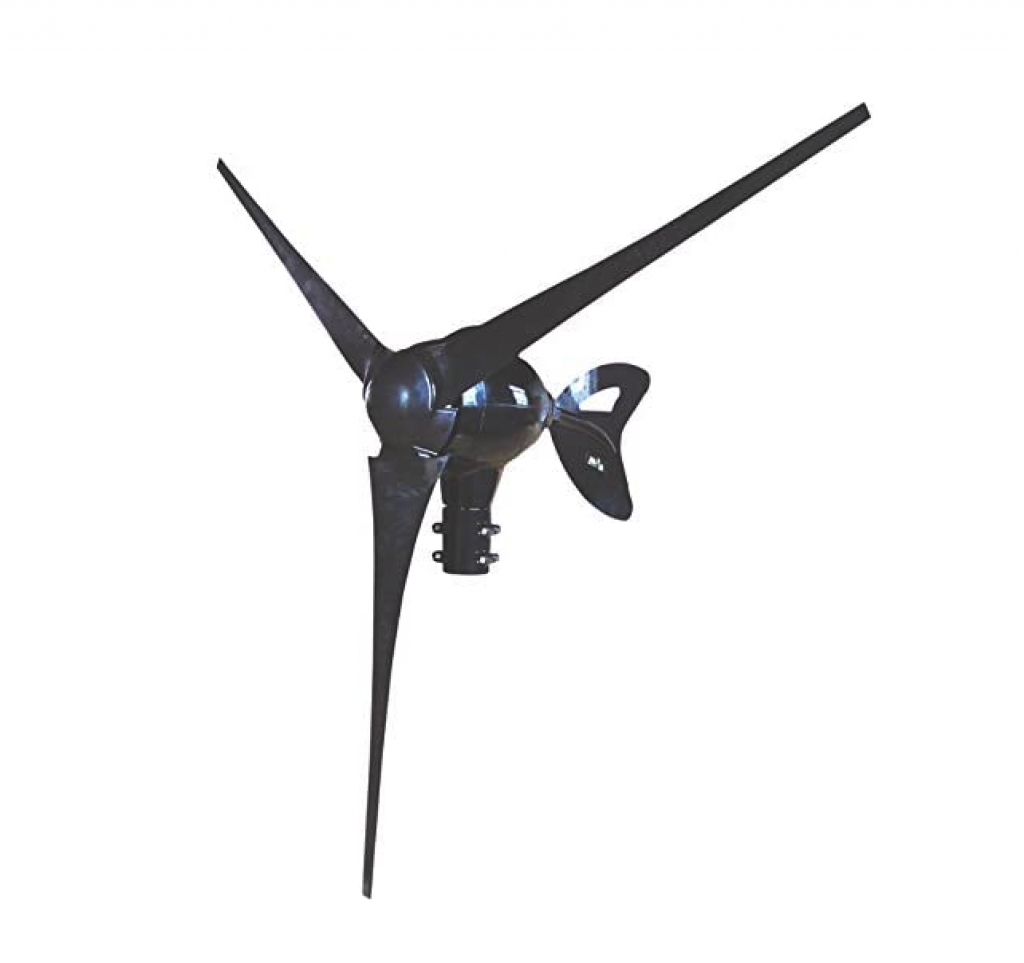
If you’re looking for a power wind turbine, this option is for you. The Nature Power 70701 is a 2kW small turbine for your home.
At $2,090 it can save you 44% of your electrical bill and has an ROI of around 48%.
This turbine is for you if you know that you have the available wind resource.
Final Thoughts
Now that we’ve walked you through the basics of wind turbines and how they can work for you, it’s time that you go out and purchase one!
Start by contacting local suppliers and reviewing wind maps — determining your wind resource is essential to calculate how much electricity you can generate.
Once you know your wind speed, you can choose a turbine that’ll be suitable for your needs. In general, a 1,5kW turbine is perfect for getting started. This wind turbine can save you 34% off your electrical bill depending on the wind resource.
Lastly, before you buy the turbine, you should calculate the ROI. This will let you know if the investment is worth it or not.
We hope that this guide helps! If you have any more questions, you can join our community and chat with us!

